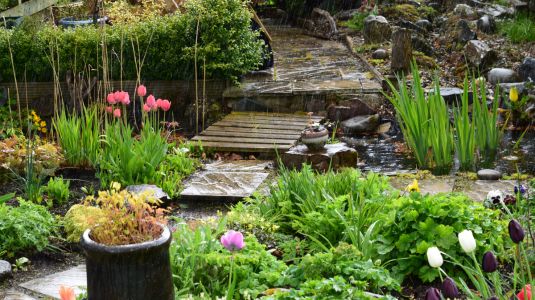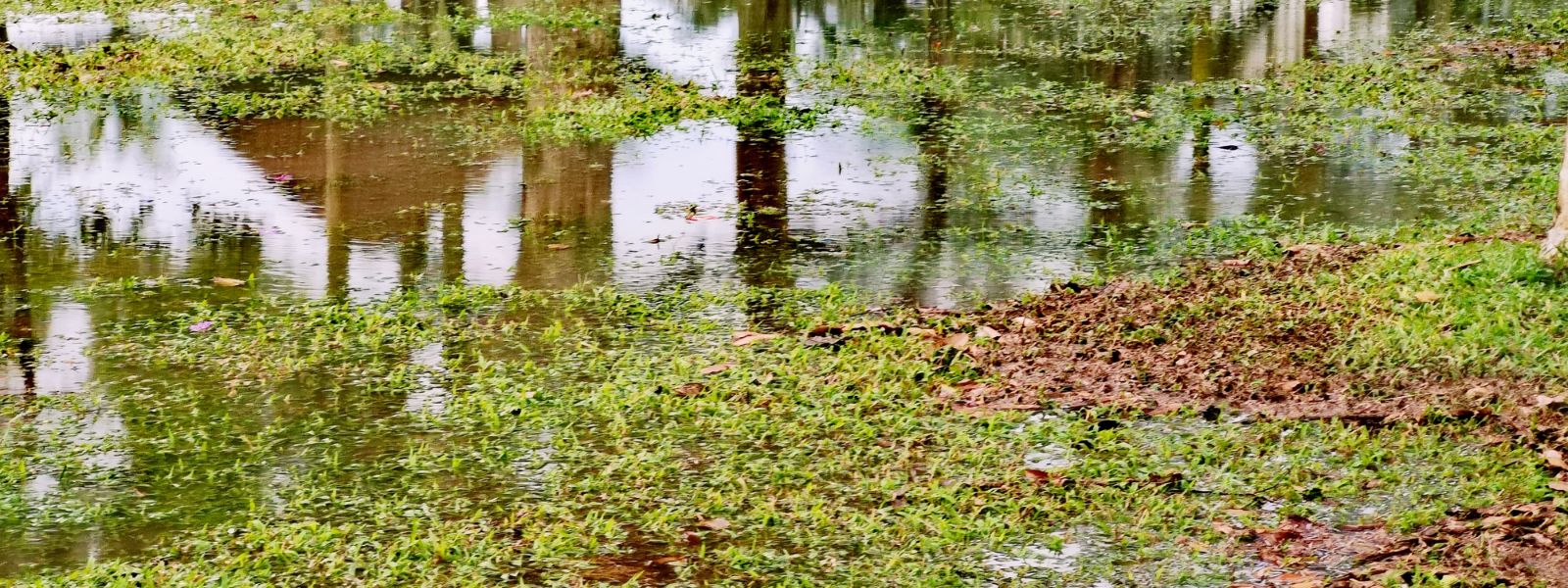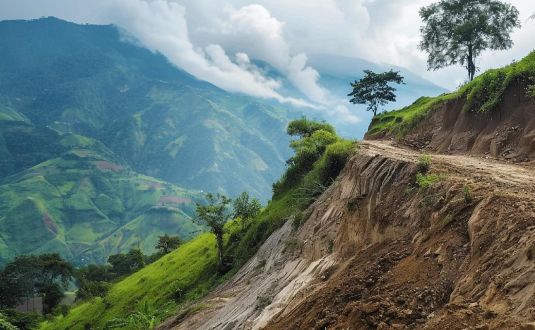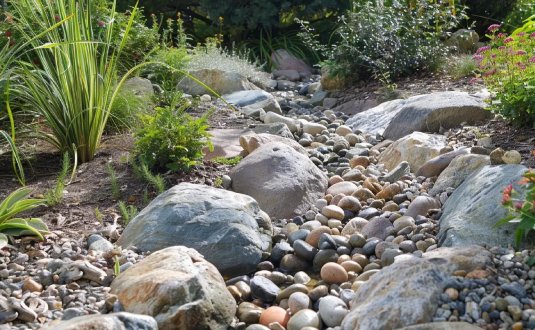Providing Best Services in Huntsville, AL
Providing Best Landscaping Services in Huntsville, AL



.webp)
What Is a Rain Garden and How Does It Help Drainage?
A rain garden is a shallow depression planted with native vegetation that captures and filters stormwater runoff from roofs, driveways, and lawns. Rain gardens solve drainage problems by temporarily storing water and allowing slow infiltration into soil rather than creating surface runoff. Rain gardens absorb 30% more water than conventional grass lawns. These landscaping features filter up to 90% of nutrients and chemicals from stormwater while reducing flooding and erosion in residential properties. The system works by collecting rainwater in engineered depressions where plant roots and specially prepared soil remove pollutants before water reaches groundwater supplies.
What Problems Do Rain Gardens Solve?
Rain gardens eliminate standing water, prevent soil erosion, and reduce stormwater pollution in residential properties. Traditional hard surfaces like concrete driveways and asphalt roofs prevent natural water absorption, creating runoff that carries pollutants directly into storm drains.
The EPA reports that urban areas generate 5 times more runoff than natural landscapes. This excess water creates muddy yard conditions, foundation damage, and flooding issues after storms. Without proper management, stormwater runoff becomes a major source of water pollution in local streams and rivers.
Conventional landscaping fails to address these drainage challenges effectively. Regular lawns shed water quickly during heavy rains, while impermeable surfaces channel water away from properties without filtration. Rain gardens interrupt this cycle by providing natural water storage and treatment areas.
Property owners face multiple drainage-related problems throughout the year. Spring snowmelt combines with rainfall to create seasonal flooding. Summer storms produce intense rainfall that overwhelms existing drainage systems. Fall leaves clog gutters and storm drains, worsening water management issues.
How Do Rain Gardens Work for Water Management?

Rain gardens function through three mechanisms: temporary water storage, soil filtration, and groundwater recharge. The engineered depression collects runoff during storms and holds water for 24-48 hours while plant roots and soil remove contaminants.
Rain garden soil contains 60% sand, 20% compost, and 20% topsoil to optimize drainage and filtration capacity. This specific mixture allows water to penetrate slowly while providing adequate nutrients for plant growth. The sand component prevents clay formation that would block water movement.
Studies show rain gardens remove over 80% of sediments, 60% of heavy metals, and significant amounts of nitrogen and phosphorus from stormwater. Plant roots absorb excess nutrients while beneficial bacteria in soil break down harmful chemicals. The filtration process occurs naturally without energy inputs or mechanical systems.
Water enters rain gardens through surface flow from surrounding areas or direct input from downspouts. The depression design slows water movement, allowing time for infiltration and pollutant removal. Overflow areas handle excess water during extreme weather events.
Native plants play a critical role in rain garden function. Deep root systems create channels for water movement while plant uptake removes nutrients that could otherwise pollute waterways. Different plant species handle varying moisture levels throughout the garden depth.
Professional drainage solutions often incorporate rain gardens as part of comprehensive water management systems. These installations address multiple drainage challenges while providing aesthetic and environmental benefits for property owners.
What Size Rain Garden Do You Need?
Rain gardens should equal 20% of the drainage area feeding into them. A 1,000 square foot roof requires a 200 square foot rain garden for optimal performance. This sizing calculation accounts for average rainfall patterns and soil infiltration rates in most geographic regions.
Most residential rain gardens need 4-8 inches of depth with gently sloping sides for safety and plant establishment. Deeper gardens handle larger water volumes but require more extensive soil preparation. Shallow gardens work well for smaller drainage areas and lighter rainfall patterns.
Garden shape affects water management efficiency. Kidney-shaped or crescent designs capture more runoff than circular gardens of equal area. Longer gardens positioned perpendicular to slopes intercept more water flow during storms.
Multiple smaller gardens often work better than single large installations. Distributed systems handle varied drainage patterns across properties while reducing excavation requirements. Connected gardens create treatment chains that improve overall water quality.
Site conditions influence rain garden sizing requirements. Clay soils need larger gardens to handle slower infiltration rates. Sandy soils allow smaller gardens due to rapid water absorption. Slope conditions affect water collection and may require size adjustments.
Where Should You Place Rain Gardens?
Rain gardens work best in naturally low areas at least 10 feet from building foundations. Proper placement requires adequate sunlight, good soil drainage, and distance from septic systems. Site selection determines long-term garden performance and maintenance requirements.
Soil must drain at least 0.5 inches per hour for basic rain garden functionality without supplemental drainage systems. Sites with slower drainage rates need underdrain installations or soil amendments to prevent standing water problems.
Utility locations affect rain garden placement options. Underground cables, pipes, and septic systems limit excavation areas. Call 811 for utility marking before selecting final garden locations. Tree root systems also influence placement decisions.
Natural water flow patterns guide optimal rain garden positioning. Observe yard drainage during rainfall events to identify collection areas. These natural depressions often provide ideal locations with minimal grading requirements.
Sunlight exposure affects plant selection and garden performance. Most rain garden plants need 4-6 hours of daily sunlight for healthy growth. Shaded areas limit plant options but can still function with appropriate species selection.
Standing water problems in existing locations may indicate suitable rain garden sites. These areas already collect water naturally and need only minor modifications for proper function.
What Plants Work Best in Rain Gardens?
Native plants perform best in rain gardens because they tolerate both wet and dry soil conditions without fertilizer requirements. Deep-rooted perennials, native grasses, and flowering shrubs provide optimal water filtration and wildlife habitat.
Large trees absorb excessive water and interfere with garden drainage function, while non-native species require more maintenance and provide less environmental benefit. Tree roots can also damage underground drainage systems over time.
Plant selection varies by geographic region and local climate conditions. Native plant societies provide species recommendations for specific areas. Extension offices often publish rain garden plant lists for different hardiness zones.
Root depth affects filtration performance. Plants with deep root systems create more soil channels for water movement. Fibrous root systems provide better nutrient uptake and soil stabilization than taproot systems.
Seasonal plant diversity maintains year-round garden function and appearance. Spring wildflowers provide early season color. Summer perennials handle peak growing season moisture. Fall seed heads provide wildlife food and winter interest.
Professional landscaping design services help select appropriate plant combinations for specific site conditions. Expert plant selection improves garden performance and reduces maintenance requirements.
How Do You Install a Rain Garden?
Rain garden installation involves excavating 6-12 inches of existing soil and replacing it with engineered growing medium. Site preparation includes drainage testing, utility location, and proper soil amendment for optimal water infiltration.
Basic installation requires shovels, rakes, wheelbarrow, garden hose for marking, and soil testing equipment. Larger gardens may need power equipment for excavation. Most homeowners complete installation in 1-2 weekends with proper planning.
Call 811 for utility location before digging. Mark garden boundaries with spray paint or garden hose. Remove existing vegetation and soil to required depth. Create gently sloping sides rather than vertical walls for safety and aesthetics.
Soil testing determines amendment requirements. Clay soils need complete replacement with sand-based mixtures. Sandy soils may need only compost additions for nutrient content. Proper soil preparation prevents long-term drainage problems.
Plant installation timing affects establishment success. Spring and fall provide optimal conditions for root development. Summer installations require more frequent watering. Winter planting works in mild climates but may delay spring growth.
Hardscaping elements enhance rain garden function and appearance. Stone spillways handle overflow during heavy rains. Rock mulch reduces maintenance needs compared to organic mulches.
What Maintenance Do Rain Gardens Require?
Rain gardens need regular weeding and plant establishment care during the first growing season. Established rain gardens with native plants require minimal maintenance compared to traditional landscaping.
First-year rain gardens need monthly weeding and plant replacement. Watering requirements decrease as plants establish deeper root systems. Mulch applications help retain soil moisture and suppress weeds during establishment.
Mature gardens require only seasonal cleanup and occasional mulch addition. Remove dead plant material in late winter before new growth begins. Add compost around plants every 2-3 years to maintain soil fertility.
Drainage performance monitoring prevents long-term problems. Check infiltration rates annually by observing water disappearance after storms. Slow drainage may indicate soil compaction or clogging that needs attention.
Invasive plant control maintains native plant communities. Remove non-native species before they establish and spread. Regular monitoring prevents invasive problems that require extensive restoration work.
Landscaping installation professionals provide maintenance services for complex gardens. Expert care maintains optimal performance and appearance while addressing technical problems.
What Are the Costs of Rain Gardens?

DIY rain garden installation costs $3-5 per square foot for materials including soil amendments, plants, and mulch. Professional installation ranges from $10-15 per square foot including design and labor.
Site preparation requirements, soil conditions, plant selection, and drainage system complexity determine final installation expenses. Clay soil sites need more extensive preparation than sandy locations. Complex drainage systems increase costs significantly.
Material costs include replacement soil, native plants, mulch, and stone for spillways. Soil amendments represent the largest expense for most installations. Plant costs vary by species selection and mature size requirements.
Labor costs depend on excavation requirements and site accessibility. Hand digging increases installation time and costs. Equipment access affects pricing for professional installations.
Long-term cost savings offset initial installation expenses. Reduced irrigation needs lower water bills. Decreased maintenance requirements save time and money compared to traditional landscaping. Property value improvements provide additional financial benefits.
What Environmental Benefits Do Rain Gardens Provide?
Rain gardens reduce water pollution by filtering 200 million gallons of contaminated runoff annually in large-scale implementations. These systems recharge groundwater supplies while creating habitat for native wildlife species.
Rain gardens remove fertilizer nutrients, road salt, petroleum products, and sediments before they reach streams and lakes. Natural filtration processes cost less than mechanical treatment systems while providing additional environmental benefits.
Groundwater recharge through natural infiltration helps maintain water table levels during dry periods. This function becomes increasingly important as climate change affects regional water availability. Rain gardens contribute to sustainable water management practices.
Wildlife habitat creation with native plant communities supports local biodiversity. Birds use plants for nesting and food sources. Butterflies and beneficial insects depend on native flowering plants. Small mammals find shelter in established gardens.
Carbon sequestration in plant tissues and soil organic matter helps address climate change. Native plants store more carbon than conventional lawn grasses. Soil development in rain gardens creates long-term carbon storage.
Yard erosion prevention protects topsoil resources and prevents sediment pollution in waterways. Plant roots stabilize soil while slowing water movement across landscapes.
When Should You Consider Professional Installation?
Complex drainage problems, steep slopes over 12%, and clay soil conditions require professional expertise. Sites with existing foundation issues or multiple drainage challenges need comprehensive evaluation and design.
Slopes exceeding 12% grade and soil infiltration rates below 0.25 inches per hour require specialized solutions. Professional assessment determines appropriate modifications and supplemental systems for challenging sites.
Large installations covering more than 400 square feet benefit from professional design and construction. Complex plant selection and drainage system integration require technical expertise. Equipment access and safety considerations favor professional installation.
Permit requirements in some jurisdictions mandate professional design for stormwater management systems. Municipal regulations may specify minimum performance standards or design criteria. Professional services provide compliance documentation.
Warranty protection and long-term support justify professional installation costs for expensive projects. Expert troubleshooting addresses performance problems and maintenance issues. Professional relationships provide ongoing technical support.
Frequently Asked Questions
How long does it take for rain gardens to drain?
Properly functioning rain gardens drain completely within 24-48 hours after rainfall events. Gardens that hold water longer than 48 hours have drainage problems that need correction. Standing water beyond this timeframe creates mosquito breeding conditions and plant stress.
Can rain gardens cause mosquito problems?
Rain gardens do not create mosquito problems when they drain properly within 48 hours. Mosquito larvae need 7-10 days of standing water to complete development. Proper drainage prevents breeding conditions while maintaining garden function.
What is the minimum distance from house foundations?
Rain gardens must be placed at least 10 feet away from building foundations to prevent water damage. Greater distances are recommended for basements or crawl spaces. Professional evaluation determines safe distances for specific site conditions.
How much rainfall can rain gardens handle?
Most residential rain gardens handle 1-2 inches of rainfall from their drainage area effectively. Larger storms require overflow provisions to prevent garden damage. Design calculations account for local rainfall patterns and extreme weather events.
Do rain gardens work in winter?
Rain gardens function year-round including winter months when soil is not frozen. Frozen soil reduces infiltration capacity but gardens still provide temporary water storage. Snow storage and gradual melting extend treatment benefits:
- Snow collection and gradual release prevent flooding
- Winter plant structure maintains soil stability
What maintenance costs should I expect?
Annual maintenance costs range $50-200 for typical residential rain gardens depending on size and plant selection. First-year establishment requires more intensive care and higher costs. Mature gardens with native plants need minimal ongoing maintenance.
Final Thoughts
Rain gardens provide effective stormwater management for residential properties while creating attractive landscape features. These systems reduce flooding, filter pollutants, and support local ecosystems through native plant establishment. Proper planning and installation create long-term drainage solutions that benefit both property owners and environmental water quality.
Success depends on appropriate site selection, proper soil preparation, and native plant establishment. Professional consultation helps address complex drainage challenges and compliance requirements. Investment in rain garden systems provides environmental benefits while solving practical drainage problems for homeowners.
Stay Connected and Inspired
Get the latest landscaping tips, seasonal care guides, and exclusive offers delivered straight to your inbox. Don’t miss out on expert advice and ideas to transform your outdoor spaces.
Sign Up for Our Newsletter Today!


Your Next Idea Awaits
Stay inspired with our latest landscaping tips and trends.
.webp)
.webp)

.webp)
.webp)
.webp)
.webp)
.webp)

.webp)








.webp)
.webp)





